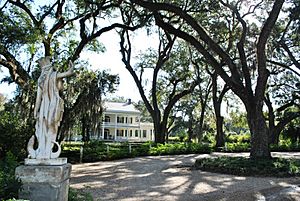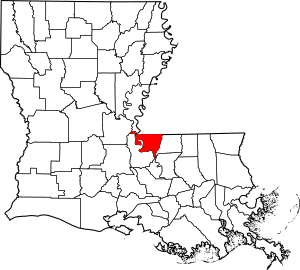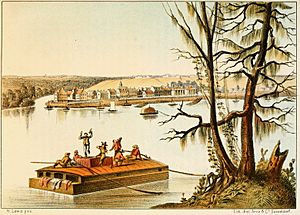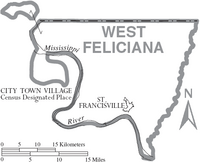West Feliciana Parish, Louisiana facts for kids
Quick facts for kids
West Feliciana Parish
|
|
|---|---|
| Parish of West Feliciana | |

|
|

Location within the U.S. state of Louisiana
|
|
 Louisiana's location within the U.S. |
|
| Country | |
| State | |
| Founded | 1824 |
| Named for | Marie Félicité de Gálvez |
| Seat | St. Francisville |
| Largest town | St. Francisville |
| Area | |
| • Total | 426 sq mi (1,100 km2) |
| • Land | 403 sq mi (1,040 km2) |
| • Water | 23 sq mi (60 km2) 5.3% |
| Population
(2020)
|
|
| • Total | 15,310 |
| • Density | 35.94/sq mi (13.876/km2) |
| Time zone | UTC−6 (Central) |
| • Summer (DST) | UTC−5 (CDT) |
| Congressional district | 5th |
West Feliciana Parish (French: Paroisse de Feliciana Ouest; Spanish: Parroquia de West Feliciana) is a civil parish located in the U.S. state of Louisiana. At the 2010 census, the population was 15,625, and 15,310 at the 2020 census. The parish seat is St. Francisville. The parish was established in 1824.
In 1824 Feliciana Parish was divided into East Feliciana Parish and West Feliciana Parish, in recognition of the increases in population throughout the parish. West Feliciana Parish is part of the Baton Rouge metropolitan statistical area.
The River Bend Nuclear Generating Station, operated by Entergy Nuclear, is located in West Feliciana Parish below St. Francisville. It produces approximately 10 percent of the total electric power demand in Louisiana. The Louisiana State Penitentiary is also located in the parish, in Angola. It occupies 18,000 acres at a site in a river bend, surrounded on three sides by water.
Contents
History
18th & 19th centuries
Following the founding of the Bayou Sara settlement by Franciscan/Capuchin monks in the late 17th century, the area was explored further by Spain, France, and Great Britain. The original settlement has been covered over by waters of the Mississippi River, which shifted course.
After 1763, when France was defeated by Britain in the Seven Years' War, it ceded this part of La Louisiane to Great Britain, which included it in its West Florida province. Spain gained control of the area in about 1780 – during the American Revolutionary War – and maintained its authority in the area for the next three decades.
In 1810, the colonists, many of whom were of British descent, rebelled against the colonial regime and established the short-lived independent Republic of West Florida. Within a few months, the United States declared the area to be part of the territory included in the Louisiana Purchase of 1803. (Today this region is called the Florida Parishes).
Feliciana Parish was established in 1810, in the Territory of Orleans, which was admitted to the Union two years later as the state of Louisiana. With continued growth of population, in 1824 Feliciana Parish was divided into the East Feliciana and West Feliciana parishes.
During the American Civil War, West Feliciana Parish provided financial assistance to the families of soldiers fighting for the Confederate States of America. Wives and children of soldiers were to receive from $10 to $40 per month, depending on family size.
West Feliciana & national politics
Since before the Civil War, West Feliciana had been historically Democratic in voter preference. But after passage of Federal civil rights legislation in the mid-1960s, many white conservatives in the South began to shift to the Republican Party, at least in terms of supporting Presidential candidates. In 1972, the year of Richard Nixon's re-election as President, West Feliciana was the only Louisiana parish to support the George McGovern and Sargent Shriver ticket. During the same period, most African Americans in the South began to support the national Democratic Party, which had helped their drive for civil rights.
Since 2000, white voters in the parish have supported the Republican Party candidates in Presidential elections. That year Bush-Cheney polled 2,512 votes (55 percent), compared to 2,187 (45 percent) for Democrats Al Gore and Joe Lieberman. West Feliciana voters helped to re-elect George W. Bush and Dick Cheney in 2004, with 2,932 (56 percent) to 2,214 (42 percent) over Democratic candidates John Kerry and John Edwards. Republicans John McCain and Sarah Palin won the parish in 2008, but they lost the Presidential/Vice-Presidential contest to Democrats Barack Obama and Joe Biden.
Geography
According to the U.S. Census Bureau, the parish has a total area of 426 square miles (1,100 km2), of which 403 square miles (1,040 km2) is land and 23 square miles (60 km2) (5.3%) is water.
The parish is located on the Mississippi River, and is bordered by Pointe Coupee Parish to the west and East Feliciana Parish to the east. The parish is about 30 miles (48 km) north of Baton Rouge and about 60 miles (97 km) south of Natchez, Mississippi.
The area—including references to the loess soil and Louisiana State Penitentiary—was used by Walker Percy as the setting for his last novel, The Thanatos Syndrome.
Major highways
Adjacent parishes and counties
- Wilkinson County, Mississippi (north)
- East Feliciana Parish (east)
- East Baton Rouge Parish (south)
- West Baton Rouge Parish (south)
- Pointe Coupee Parish (southwest)
- Avoyelles Parish (northwest)
- Concordia Parish (northwest)
National protected area
Demographics
| Historical population | |||
|---|---|---|---|
| Census | Pop. | %± | |
| 1820 | 12,732 | — | |
| 1830 | 8,629 | −32.2% | |
| 1840 | 10,910 | 26.4% | |
| 1850 | 13,245 | 21.4% | |
| 1860 | 11,671 | −11.9% | |
| 1870 | 10,499 | −10.0% | |
| 1880 | 12,809 | 22.0% | |
| 1890 | 15,062 | 17.6% | |
| 1900 | 15,994 | 6.2% | |
| 1910 | 13,449 | −15.9% | |
| 1920 | 12,303 | −8.5% | |
| 1930 | 10,924 | −11.2% | |
| 1940 | 11,720 | 7.3% | |
| 1950 | 10,169 | −13.2% | |
| 1960 | 12,395 | 21.9% | |
| 1970 | 11,376 | −8.2% | |
| 1980 | 12,186 | 7.1% | |
| 1990 | 12,915 | 6.0% | |
| 2000 | 15,111 | 17.0% | |
| 2010 | 15,625 | 3.4% | |
| 2020 | 15,310 | −2.0% | |
| U.S. Decennial Census 1790–1960 1900–1990 1990–2000 2010–2013 |
|||
2020 census
| Race | Number | Percentage |
|---|---|---|
| White (non-Hispanic) | 10,585 | 69.14% |
| Black or African American (non-Hispanic) | 3,589 | 23.44% |
| Native American | 95 | 0.62% |
| Asian | 30 | 0.2% |
| Pacific Islander | 5 | 0.03% |
| Other/Mixed | 355 | 2.32% |
| Hispanic or Latino | 651 | 4.25% |
As of the 2020 United States census, there were 15,310 people, 3,869 households, and 2,497 families residing in the parish.
2019 ACS
The 2019 American Community Survey estimated 15,428 people lived in the parish, down from 15,625 at the 2010 United States census, and up from 15,111 at the 2000 U.S. census. Among the population, the median age was 41.4. In 2000, the parish the population was spread out, with 20.30% under the age of 18, 8.70% from 18 to 24, 40.00% from 25 to 44, 23.80% from 45 to 64, and 7.20% who were 65 years of age or older. The median age was 37 years. For every 100 females, there were 191.10 males. For every 100 females age 18 and over, there were 223.60 males.
The racial and ethnic makeup was 53.5% non-Hispanic white, 44.5% Black and African American, 0.2% American Indian and Alaska Native, 0.6% Asian alone, 0.1% some other race, 1.1% two or more races, and 1.2% Hispanic and Latin American of any race. In 2000, the racial makeup of the parish was 50.51% Black or African American, 48.63% White, 0.20% Native American, 0.17% Asian, 0.02% Pacific Islander, 0.03% from other races, and 0.44% from two or more races; 1.04% of the population were Hispanic or Latin American of any race.
In 2019, there were 3,869 households and 5,446 housing units. The parish had a home-ownership rate of 73.2%, and the median housing value was $229,500. Median gross rent was $785, and the median household income was $59,637. Approximately 23.6% of the population lived at or below the poverty line. At the 2000 census, the median income for a household in the parish was $39,667, and the median income for a family was $47,239. Males had a median income of $35,046 versus $21,922 for females. The per capita income for the parish was $16,201. About 15.00% of families and 19.90% of the population were below the poverty line, including 25.30% of those under age 18 and 23.40% of those age 65 or over.
In January 2007, the state of Louisiana estimated that 15,318 people lived in the parish, with 5,000 of them being prisoners at Louisiana State Penitentiary (Angola).
Communities
Town
Unincorporated communities
Education

West Feliciana Parish Public Schools serves the parish. All residents are zoned to Bains Lower Elementary School, Bains Elementary School, West Feliciana Middle School, and West Feliciana High School. Tunica Elementary School, a parish elementary school, was closed after the parish school board voted to close the school in May 2011.
Some students in the parish attend Wilkinson County Christian Academy in Wilkinson County, Mississippi.
The West Feliciana Parish Library is located in St. Francisville. The library, previously a part of the Audubon Regional Library System, became independent in January 2004.
The parish's proximity to Baton Rouge offers access to Louisiana State University, Southern University, and Baton Rouge Community College. It is in the service area of Baton Rouge Community College.
Notable people
- General Robert Hilliard Barrow (February 5, 1922 – October 30, 2008) was the 27th Commandant of the United States Marine Corps (USMC) from 1979 to 1983. Barrow served for 41 years, including overseas command duty in three wars. He was awarded the Navy Cross and the Distinguished Service Cross. He grew up on his family's Rosale Plantation in West Feliciana Parish. He is interred at the Grace Episcopal Church Cemetery in St. Francisville.
- Rob Couhig, New Orleans businessman and politician, was reared in West Feliciana Parish.
- Cheston Folkes, Louisiana state representative from West Feliciana Parish, 1908–1920, 1924–1932, and 1936–1940
- Warren Davis Folkes, member of both houses of the Louisiana legislature from West Feliciana Parish from 1944 to 1976
- Samuel Lawrason, St. Francisville attorney and state senator who authored the Lawrason Act of 1898.
- Sam A. LeBlanc, III, lawyer and politician; half-brother of Rob Couhig, retired to St. Francisville c. 2006
- Tom McVea, state representative
- John Richard Rarick, attorney and U.S. Representative from St. Francisville.
- Major Thibaut, state representative since 2008 for District 18, which includes West Feliciana Parish; businessman from Pointe Coupee Parish
- E. M. Toler, state senator from East and West Feliciana parishes from 1944 to 1954; physician from Clinton, Louisiana
- Sheadrick Turner (1869–1927), Illinois state representative, newspaper editor, and lawyer
See also
 In Spanish: Parroquia de West Feliciana para niños
In Spanish: Parroquia de West Feliciana para niños




